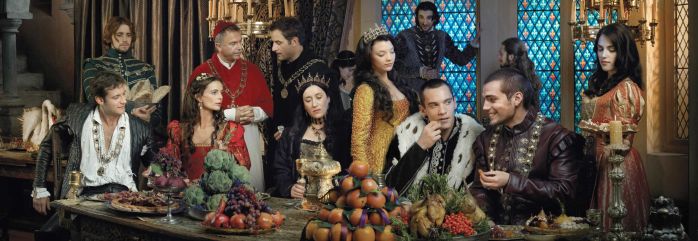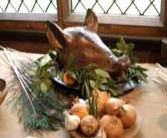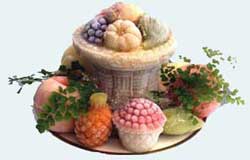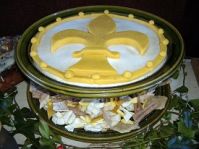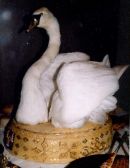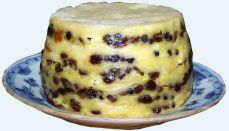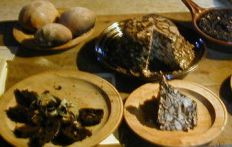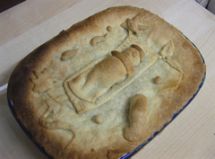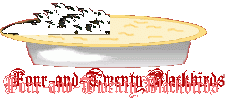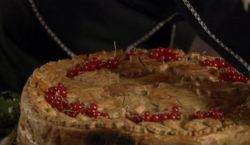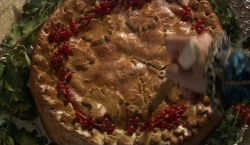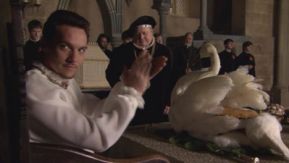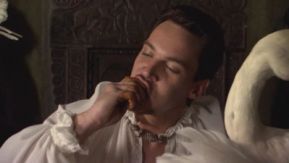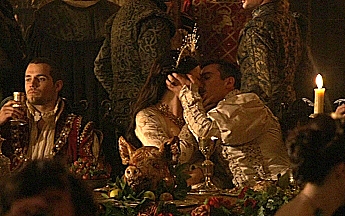FOOD of the Tudors
Jump to navigation
Jump to search
| Sing a song of sixpence a pocket full of rye, Four and twenty blackbirds baked in a pie. When the pie was opened the birds began to sing, Oh wasn't that a dainty dish to set before the king? The king was in his counting house counting out his money, The queen was in the parlour eating bread & honey The maid was in the garden hanging out the clothes, When down came a blackbird & pecked off her nose! | 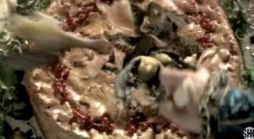 | In season 1, Henry VIII gives Francis I a gift of a pie which birds fly out of when it is cut open. [For a video clip : you can find it at <a class="external" href="http://www.sho.com/site/tudors/episodes.do" rel="nofollow" target="_blank">Showtime's website</a> - click videos for Season 1 Episode 2 and "A Surprising Gift" "During the Medieval times, there were occasions when the cook in the house of a wealthy knight did indeed put live birds (often pigeons, but I'm sure it could just as easily have been blackbirds) inside a huge pastry crust, on his own initiative. This was seen as a great joke and the cook would usually have a real pie waiting to bring in when the birds had been released." |
| Recipe: To make Pies that the Birds may be alive in them, and flie out when it is cut up. From <a class="external" href="http://www.thousandeggs.com/gretepye.html" rel="nofollow" target="_blank">Epulario</a>, 1598 (Olde English) Make the coffin of a great pie or pastry, in the bottome thereof make a hole as big as your fist, or bigger if you will, let the sides of the coffin bee somewhat higher then ordinary pies, which done put it full of flower and bake it, and being baked, open the hole in the bottome, and take out the flower. Then having a pie of the bigness of the hole in the bottome of the coffin aforesaid, you shal put it into the coffin, withall put into the said coffin round about the aforesaid pie as many small live birds as the empty coffin will hold, besides the pie aforesaid. And this is to be done at such time as you send the pie to the table, and set before the guests: where uncovering or cutting up the lid of the great pie, all the birds will flie out, which is to delight and pleasure shew to the company. And because they shall not bee altogether mocked, you shall cut open the small pie, and in this sort you may make many others, the like you may do with a tart. |
| On the second season finale, Henry is presented with a beautiful swan made into a meat pie by his master chef, which he devours gluttonously. Swans and all other varieties of water fowl were eaten well into the 20th century in Europe and North America. During the Tudors, they were especially desirable as a centerpiece for a wedding feast. The British loved to eat all sorts of meat pies and there are several old recipes. In the middle ages and renaissance a pie made of game bird or water fowl, such as swan, would often have parts of the original animal stuffed as part of the presentation, such as the peacock pie in the center. For a roast swan recipe, the bird was often "redressed" in its skin and feathers after roasted so it appeared as it did before it was cooked. | Roast Swan | For a roast swan, the dish is usually made with a sauce called chaudon made of vinegar, spices, and broth made from the swan's blood and giblets. After the meat is cooked it can easily be baked in a thickened sauce in a pastry crust. For to prepare a swan. Take & undo him & wash him, & do on a spit & lard him fair & roast him well; & dismember him on the best manner & make a fair carving, & the sauce thereto shall be made in this manner... -from <a class="external" href="http://www.godecookery.com/mtrans/mtrans52.html" rel="nofollow" target="_blank">14th century English</a> recipe <a class="external" href="http://www.daviddfriedman.com/Medieval/Cookbooks/Menagier/Menagier.html#fn71" rel="nofollow" target="_blank">How to redress a roast swan in it's own feathers</a> according to a 14th century French recipe No swan handy? The recipe can be altered for goose or turkey. |
"The gastronomic well-being of English men in the sixteenth century was proverbial, and rarely did a foreign traveller refrain from commenting upon the fact that farmers and yeomen ate almost as well as gentlemen and nobles. In a period of three days, Elizabeth's court managed to consume 67 sheep, 34 pigs, 4 stags, 16 bucks (used to make 176 meat pies), 1,200 chickens, 363 capons, 33 geese, 6 turkeys, 237 dozen pigeons, 2,500 eggs and 430 pounds of butter, plus a cartload and two horseloads of oysters. Such abundance was limited to State functions, but Henry VIII regularly spent over 1520 [pounds] a year on food for himself and his queen, and the Duchess of Norfolk commonly sat down to a table set for twenty and served as her first course two boiled capons, a breast of mutton, a piece of beef, seven chevets, a swan, a pig, a breast of veal, two roasted capons, and a custard. When Mr Henry Machyn, the undertaker, could polish off with the help of eight friends half a bushel of oysters, a quantity of onions, red ale, claret, and malmsey at eight in the morning, the extent of royal consumption, though still prodigious, no longer appears disproportionate to that of the rest of society. The usual royal fare consisted of such fattening delicacies as venison, mutton, carp, veal, swan, goose, stork, capon, conies, custard, fritters, and six gallons of beer and a sexter of wine to wash down what was only the first course. Then followed jellies, cream of almond, pheasant, hern, bittern, partridge, quail, ****, gulls, kid, lamb, tarts, more fritters, eggs, butter, and finally fruit with powdered sugar. Not content with mere quantity, the eye as well as the stomach had to be satiated, and on special occasions dishes were transformed into a riot of colour and form, representing heraldic, historic and classical scenes. The rich man's table was loaded to overflowing and appetites matched the supply, but it must be remembered that waste was an economic necessity. Everybody from the household servant to the passing beggar was expected to make do with the leftovers. " ~ Lacey Baldwin Smith in A Tudor Tragedy |
| 200 members of the kitchen staff provided meals of up to 14 courses for the 600 - 800 people in the king's court. Here are some dishes served at a typical feast: 1. Spit-Roasted Meat Spit-roasted meat -- usually a pig or boar -- was eaten at every meal. It was an expression of extreme wealth because only the rich could afford fresh meat year-round; only the very rich could afford to roast it, since this required much more fuel than boiling; and only the super wealthy could pay a "spit boy" to turn the spit all day. In a typical year, the royal kitchen served 1,240 oxen, 8,200 sheep, 2,330 deer, 760 calves, 2,870 pigs, 33,000 chickens, 24,000 larks and 53 wild boar. That's more than 14,000 large animals, meaning each member of the court was consuming about 23 animals every year 2. Grilled Beavers' Tails These tasty morsels were particularly popular on Fridays, when according to Christian tradition, it was forbidden to eat meat. Rather conveniently, medieval people classified beavers as fish. 3. Whale Meat Another popular dish for Fridays, whale meat was fairly common and cheap, due to the plentiful supply of whales in the North Sea, each of which could feed hundreds of people. It was typically served boiled or very well roasted. 4. Whole Roasted Peacock This delicacy was served dressed in its own iridescent blue feathers (which were plucked, then replaced after the bird had been cooked), with its beak gilded in gold leaf. 5. Internal Organs If you're squeamish, stop reading now. Medieval cooks didn't believe in wasting any part of an animal, and in fact, internal organs were often regarded as delicacies. Beef lungs, spleen, and even udders were considered fit for a king and were usually preserved in brine or vinegar. 6. Black Pudding Another popular dish -- still served in parts of England -- was black pudding. This sausage is made by filling a length of pig's intestine with the animal's boiled, congealed blood. | 7. Boar's Head A boar's head, garnished with bay and rosemary, served as the centerpiece of Christmas feasts. It certainly outdoes a floral display. 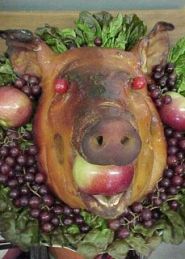 A Wild Boar's head stuffed with fruit was usually the principal and choicest dish at any feast especially Christmas. Why it should have been so highly esteemed we cannot now tell; but possibly the danger encountered in attacking so ferocious an animal as the wild boar, and the consequent importance attaching to it when slain, as a trophy of victory, may have had an influence in raising it to the position it enjoyed. It was usually brought to table with great ceremony; trumpeters preceded the bearer, sounding, and various other persons attended and formed a procession. In the household accounts of King Henry VIII we find an entry of 24th November, 1529, of a payment to a servant of the Lord Chamberlain of 40s "in rewarde for bringing a wylde bore unto the king," and on the last day of December in the same year, a like sum of 40s was paid to one of the Lord Chamberlain's servants for a similar service. A servant of "Maister Tresorer" received 4s 8d on 18th December, 1531, "for bringing a wylde bore's head to the king." 8. Roasted Swan Roasted swan was another treat reserved for special occasions, largely because swans were regarded as too noble and dignified for everyday consumption. The bird was often presented to the table with a gold crown upon its head. To this day, English law stipulates that all mute swans are owned by the Crown and may not be eaten without permission from the Queen. 9. Vegetables Perhaps the only type of food Henry and his court didn't consume to excess was vegetables, which were viewed as the food of the poor and made up less than 20 percent of the royal diet. | 10. Marzipan A paste made from ground almonds, sugar, and egg whites and flavored with cinnamon and pepper, marzipan was occasionally served at the end of a meal, although desserts weren't common in England until the 18th century when incredibly elaborate sugar sculptures became popular among the aristocracy. 11. Spiced Fruitcake The exception to the no dessert rule was during the Twelfth Night banquet on January 6, when a special spiced fruitcake containing a dried pea (or bean) was served. Whoever found the pea would be king or queen of the pea (or bean) and was treated as a guest of honor for the remainder of the evening. 12. Wine and Ale All this food was washed down with enormous quantities of wine and ale. Historians estimate that 600,000 gallons of ale (enough to fill an Olympic-size swimming pool) and around 75,000 gallons of wine (enough to fill 1,500 bathtubs) were drunk every year at Hampton Court Palace. [HowStuffWorks by the editors of Publications International] 13 Cockentrice 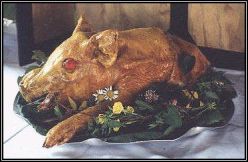 In a lavish dinner to impress the king of France, Henry VIII spent the equivalent of £5 million on a meat feast including 2000 sheep, 1000 chickens and a dolphin. Not content with real life animals, Tudor chefs also enjoyed bolting together bits of different creatures to make a dramatic beastie they called a cockentrice One of the more fanciful and imaginative dishes of the Middle Ages was the cockentrice, made by combining a pig and a capon into one creature, thus creating a "new" animal that would not only feed hungry folk but amuse and amaze them as well. "Cockentrice" is actually just one among many spellings of the name of this dish; originally the beast was also known as a cokagrys or cotagres, from "****" (a capon) and "grys" (a pig); a "gryse" was a suckling pig. Other period spellings include koketris, cocagres, cokyntryche, cockyntryce, and cokantrice. Cockentrice were common entries at great dinners, and a cokyntryche is listed among the many feast items at a festival given by John Stafford, Bishop of Bath & Wells, on September 16, 1425. Incidentally, the cockentrice is NOT the infamous Cockatrice, that fabulous mythical serpent that had the power to kill with a glance. Our edible cockentrice is a much safer and delicious creature. <a class="external" href="http://www.godecookery.com/cocken/cocken04.htm" rel="nofollow" target="_blank">Recipe for Cockentrice</a> |
Links:
|
Save
